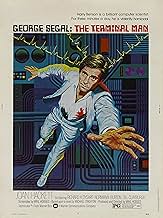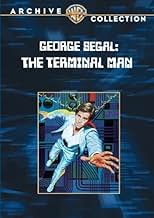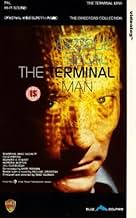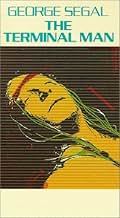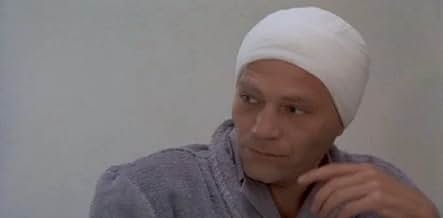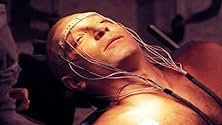Füge eine Handlung in deiner Sprache hinzuHoping to cure his blackout seizures which turn him temporarily extremely violent, a computer scientist agrees to an experimental brain computer chip implant surgery.Hoping to cure his blackout seizures which turn him temporarily extremely violent, a computer scientist agrees to an experimental brain computer chip implant surgery.Hoping to cure his blackout seizures which turn him temporarily extremely violent, a computer scientist agrees to an experimental brain computer chip implant surgery.
- Regie
- Drehbuch
- Hauptbesetzung
- Dr. John Ellis
- (as Richard A. Dysart)
- Det. Capt. Anders
- (as Normann Burton)
Empfohlene Bewertungen
The plot centres on a group of scientists and doctors who are pushing the frontiers of neuroscience by implanting a computerized chip in the brain of a man (George Segal) afflicted with terrible seizures. The chip is programmed to shock the patient's brain each time a seizure is about to happen. The effort is prestigious, the technology flawless, and the doctors, scientists and technicians react to the initial success of the project with a certain conceited arrogance. Only when the the chip malfunctions, and the patient breaks out of the hospital and starts killing people, does the veneer of omnipotence and professionalism fall away, revealing in the scientists ambition, uncertainty, and humanity.
Segal does a good job of portraying the wildly changing emotions of a man who's mind is under the control of a computer. At the push of a button he can be made to laugh, cry, scream, babble like a child, or even become aroused, as the computer chip in his brain explores his mental map. It's a study that would be interesting to fans of Oliver Sacks.
The most interesting moments of the movie are the early ones, where the patient interacts with his dispassionate doctors in the sterile, streamlined chromium world of the hospital. The doctors and scientists seem like mechanical, perfected reflections of the technologies that surround them. The messy humanity of the patient, demonstrated through humour, fear, weakness and anger, stands in contrast to his surroundings, and it is not surprising to the audience when he disappears from his hospital room.
Scenes of the doctors in tuxedos and evening gowns at a dinner party while a shiny computer console monitors their ailing patient lend the robotic professionals a strange, formal humanity, at the same moment in the movie when their own fallibility begins to be revealed. Both technology and technologists promise perfection, and in the end both are revealed as imperfect and unable to overcome the challenges of the human condition - sickness, insanity, violence and death.
Once the patient leaves the hospital, the movie shifts to a more conventional 'crazed murderer' theme, and things become less interesting. It is this shift that cripples Terminal Man and prevents it from being the science fiction classic it might have been. The movie closes with a disappointing, clichéd 'Big Brother' riff on mind control and the future.
This is still a movie worth watching, however, if only to get a glimpse of how the 1970s saw the near future. There are endless details for the technophile, from absurdly technological architecture to atomic batteries to ancient video terminals to mainframe computers to futuristic touchtone telephones. The technological landscape is presented with a glistening newness that evokes movies like The Anderson Tapes, Coma, Westworld, and The Andromeda Strain (the last three of which, like Terminal Man, were written by Michael Crichton). The set design and the soundtrack (mostly Bach, No. 25 in the Goldberg Variations) create an inviting, peaceful sense of space that stands at odds with the tension of the plot. The clean, elegant world of Terminal Man is one in which you would want to live.
Watch Terminal Man for the sets, for the music, and for its nostalgic sense of a forgotten future. Back in the 70s, this was the future everyone was expecting, if not hoping to find right around the corner. Like Andromeda Strain, Coma and the Anderson Tapes, Terminal Man is less a thriller and more a cultural time capsule. Get comfortable in your beanbag chair, turn on the lava lamp, and enjoy.
I urge anyone with an IQ larger than their shoe size to ignore the negative comments and give this film a chance. Viewed with an open mind and a little patience, this movie becomes quite an exiting experience. It's one of the greatest sci-fi/horror films of all time, and has never gotten its due respect. It's the kind of film we could use more of, and the fact it's considered boring by today's audiences is very sad proof of the dumbing-down effect of Hollywood clap-trap. We're used to movies that ask you to set back while you're force-fed the story. The Terminal Man requires that you watch what's happening, listen to what's being said, and think about what's between the lines. If you can't do that, stick with Vin Diesel films.
The likable George Segal stars as Harry Benson, a computer scientist who, since a car accident, has suffered from blackouts & seizures that made him dangerously violent. Now a team of surgeons is performing ground breaking surgery on him: attaching electrodes to 40 of his brain terminals that will hopefully counteract his violent impulses. However, as the viewer certainly suspects will happen, this doesn't work, and his brain ends up craving the shocks / stimuli that it receives, and Harry loses control once again.
I can certainly understand the problems that some people may have with this production, as it's really not the typical thriller at all. It's slow, and it's quiet; there's not even that much musical accompaniment on the soundtrack. It does exhibit a fairly cold, clinical approach, and the emphasis on the story's exposition will inevitably bore people more conditioned to non- stop action in what they watch. Even after Harry has made the expected escape from the hospital, he doesn't spend that much time running amok, and certainly does not kill very many people.
But this movie *is* noticeably intelligent and thoughtful and does offer rewards for patient viewers. It has one striking murder set piece that's rather artfully done; it takes place atop a water bed, and the sprays of water and the way the blood spreads definitely are what make the scene. And, like other movies of this kind, there is a certain wariness (voiced by Harry) on the part of mankind regarding the computer age and what it could mean for us all.
Another wonderful element to "The Terminal Man" is its incredible cast of both stars and rock solid character actors. Segal is effectively low key in the lead, and is nicely supported by Joan Hackett, Jill Clayburgh (in a small but welcome appearance), Richard Dysart, Donald Moffat, Matt Clark, Michael C. Gwynne, William Hansen, and Norman Burton. (It's particularly fun to see Dysart and Moffat sharing scenes eight years before they did John Carpenters' "The Thing" together.) And playing smaller roles are the likes of James B. Sikking, Steve Kanaly, Jack Colvin, Ian Wolfe, Lee de Broux, Victor Argo, and Nicholas Worth.
This is all reasonably engaging stuff, leading up to an ending that, while somewhat conventional, is staged in a very unique way. All in all, "The Terminal Man" is a good movie that does deserve to be discovered or rediscovered.
Seven out of 10.
George Segal is believable as Harry, and the rest of the cast is fine, and though Mike Hodges tries, this film is simply too dreary and downbeat to succeed, and by the end, there doesn't seem to have been any discernible point to it all.
Today's audiences however, with their short attention spans, will likely be permanently disappointed. To those who complain that this film is "slow" (and they are legion); I would say to either learn some patience, or simply avoid the film and go back to watching action/adventure.
While made in the early 1970's, it is highly relevant to today's world as well. Replace the "wires in the brain" with today's over-prescribed Ritalin, SSRI's, and other similar drugs, and you will see the point.
This is an excellent movie which deserves to be on DVD, with commentary by Crichton, Hodges and/or Segal. They are all still with us as of 4/2008 (Sadly Ms. Hackett is not). The sooner the better.
Wusstest du schon
- WissenswertesCrichton was fired from writing the screenplay due to the fact that his script did not follow the novel (which he had written) closely enough.
- PatzerAt the cemetery, the usual mechanism for lowering the coffin into the grave is missing. There aren't even any straps in place to lower it manually.
- Zitate
Benson: [mumbles]
Dr. John Ellis: [operating on Benson] What was that?
Dr. Robert Morris: Patient.
Dr. John Ellis: You all right, Mr. Benson?
Benson: [groggily] Fine... fine...
Dr. John Ellis: Any pain?
Benson: No...
Dr. John Ellis: Good. Just relax now.
Benson: You too doctor...
- Alternative VersionenOn its release at 2003 Edinburgh Film Festival, there was a director's cut which Hodges had cut out the beginning with the doctor looking at photographs of Harry Benson.
- VerbindungenFeatured in Cinemacabre TV Trailers (1993)
- SoundtracksGoldberg Variation No. 25
by Johann Sebastian Bach (as J.S. Bach)
Played by Glenn Gould
Courtesy Columbia Records
Top-Auswahl
- How long is The Terminal Man?Powered by Alexa
Details
- Erscheinungsdatum
- Herkunftsland
- Sprache
- Auch bekannt als
- El hombre terminal
- Drehorte
- Produktionsfirma
- Weitere beteiligte Unternehmen bei IMDbPro anzeigen
Box Office
- Bruttoertrag in den USA und Kanada
- 224.542 $
- Laufzeit1 Stunde 44 Minuten
- Sound-Mix
- Seitenverhältnis
- 1.85 : 1
Zu dieser Seite beitragen



